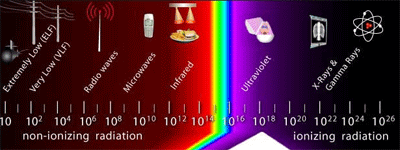Differences Between X-rays and Gamma rays
 X-rays vs Gamma rays
X-rays vs Gamma rays
Gamma rays, x-rays, visible light and radio waves are all types (forms) of electromagnetic radiation. Electromagnetic radiation can be described in terms of a stream of photons, which are particles without mass, each traveling in a wave-like pattern and moving (circling) at the speed of light. We will examine the x-rays and the gamma rays. X-rays are used in our common day-to-day life. For example they are used at airport security, in Roentgen Stereophotogrammetry, crystallography, astronomy, industrial applications, fluorescence etc. Gamma rays are not so used much in common life because they are more radioactive (dangerous) and because they kill living cells. Still, they can and are used by humans in different manner. They are used for irradiation, nuclear medicine, altering the semi-precious stones, sterilizing medical equipment, pasteurizing certain foods and spices, gauging the thickness of certain metals, measure soil density at construction sites etc. A low-dose exposure of the gamma rays can be most likely fought fast by the body (cells), while a high-dose exposure could damage the cells and slow the healing process. Gamma emitting radionuclides are the most widely used radiation sources. The earth’s atmosphere is thick enough not to let any X-rays and almost no gamma rays to go all the way from outer space to us on the surface of the earth. Let’s observe the differences between these 2 types of electromagnetic radiation.
There are a few more differences between X-rays and Gamma Rays. The key difference is the source: x-rays are emitted by the electrons outside the nucleus, and gamma rays are emitted by the excited nucleus itself.
Another difference lies in their frequencies. X rays’ frequencies vary from 30 petahertz to 30 exahertz, and Gamma rays are above 10^19 Hz. Their wavelengths are also varying. The gamma rays’ wavelength is smaller than that of the x-rays’. Gamma-ray photons have the highest energy in the EMR spectrum and their waves have the shortest wavelength.
Gamma rays are a lot more dangerous and hazardous to human health than X-rays. Moreover gamma rays are the highly penetrating and highly energetic ionizing radiation. On prolonged exposure to living beings they can cause cancer. Since there wavelength is very small, they have an ability to penetrate through any gap even if it is a sub-atomic gap. The most damaging are the ones which fall in the window of 3 and 10 MeV.
Gamma rays are sometimes produced along with other types of radiation like alpha and beta. However this is not the case with x rays.
Summary:
1.Gamma rays cause more harm to human body than the X- rays.
2.Gamma rays have shorter wavelengths than the X-rays.
3.X rays are emitted by the electrons outside the nucleus, and gamma rays are emitted by the excited nucleus itself.
4.X rays are used in hospitals for taking X-rays but gamma rays are not.
- Difference Between Schizophrenia and Psychosis - March 7, 2024
- Difference Between African and Asian Elephants - March 7, 2024
- Difference Between Sunscreen and Sunblock - February 15, 2024

i think this article full of mistakes as we know that both x -ray and gamma ray are used in hospitals to treat cancer . also x-ray energy can exceed gamma rays , it reach 18 mev or more .
Think Its a great website definitely useful. I love the summary of the points at the end.
Lacks content on both medical and physical sciences sides, But more from a physics point of view. This is more general knowledge I feel.
Sir which more penetrating power x ray or gamma ray
Gamma rays are more penetrating
This article is for a 8th standard student. Though works good.
Good article, It proved very helpful for me
Good article, It proved very helpful for me..Nice one